
BY MILOS MILENKOVIC
Postdoctoral Research Fellow at the MIT-Zaragoza International Logistics Program
Imagine a worldwide system for goods transport that worked like the internet: Goods are conveyed in standardised “packets” or containers. The network neither knows nor cares about the contents of each container. The network decides autonomously on the best route — carriers, vehicles, nodes and modes — and can modify the routing in response to changing circumstances. Switching between carriers, vehicles and modes would incur only trivial penalties in cost and time. Neither sender nor recipient needs to know or understand the detail of how the container is conveyed. The whole network operates under internationally recognised protocols and is open to any user. The transformation in transport efficiency would be a major contribution to the challenge of global logistics sustainability.
That concept is known as the Physical Internet (PI, or, inevitably, π). First promulgated by Benoit Montreuil of Montreal’s CIRRELT (Interuniversity Research Centre on Enterprise Networks, Logistics and Transportation) and others a decade ago, π may sound like a purely theoretical model. However, all the required technological elements already exist, and many have been piloted. Any barriers are economic, social and political, not technical.
All the required technological elements to create the Physical Internet already exist, and many have been piloted
Why should a Physical Internet be created?
Despite centuries of incremental improvement, the many inefficiencies of existing transport and logistics systems continue to create serious negative economic, environmental and social impacts. Economically, transport costs continue to increase, outweighing savings made in other parts of the supply chain. Social impacts range from externalities including accidents, pollution and noise to the wasted time, unsocial hours and working conditions experienced by drivers and others.
Environmentally, transport is one of the largest contributors to greenhouse gas emissions — 28% across the EU — and although EU emissions overall are decreasing, transport emissions increased by 0.9% in 2018 and a further 0.8% in 2019. Creating a Physical Internet would contribute to tackling the following challenges:
- Available transport capacity is underused. Freight cars, lorries and containers are often half empty, to a large extent because of inefficient, oversized packaging.
- Return flows are empty, as transport operators fail to take advantage of opportunities for back-haulage. A quarter of all road journey legs run unloaded.
- Storage and distribution facilities are often underutilised or inefficiently used for large parts of the year due to seasonality in products and markets.
- Road transport is dominant despite environmental impacts. In 2019, road freight transport accounted for 76.3% of total inland freight transport, expected to grow at a compound annual growth rate of 3% in 2021-25. Drivers are in short supply.
- Operational inefficiencies work against more desirable options. The different modes are poorly synchronised, and transshipment between modes is neither time nor cost efficient. Yet trains are four times as fuel efficient as lorries, and moving freight by rail rather than road lowers greenhouse gas emissions by 75%.
- Last-mile delivery logistics is inefficient, especially in urban areas. Around 40% of the transport costs incurred by a product are accrued in the last mile, and city logistics is responsible for 70% of urban traffic congestion. Continuing growth in e-commerce implies yet higher frequencies of smaller deliveries to ever more destinations.
Current demand for freight transport is expected to triple in volume by 2050, which is clearly unsustainable socially and economically, let alone environmentally. It is vital that we find innovative approaches and concepts in logistics and freight transport that will decouple economic growth from a rise in freight traffic. The Physical Internet, π, is one such approach.
The Physical Internet holds promise to decouple economic growth from a rise in freight traffic, which is expected to triple in volume by 2050
An internet for stuff
A formal definition of the Physical Internet is “an open, global and multimodal logistics system founded on universal physical, digital and operational interconnectivity and enabled through standard encapsulation, protocols and interfaces.”
We can unpack this by exploring the analogies between the Physical Internet and the familiar Digital Internet. The Digital Internet connects billions of devices all over the world, allowing every device to communicate with all others. Users can be private, commercial or governmental: anyone with access to a computer or smartphone. The Physical Internet can similarly connect and be used by any consignor and consignee. (In both networks, it may be necessary to devise ways of barring bad actors).
In the Digital Internet, information is broken down into data packets and transmitted via a network of communication links. The data within a packet is encapsulated and is not viewed or processed by the internet; similarly, in the Physical Internet, a flow of goods is sealed in a series of standard containers, and π is not concerned with the contents. (Other agencies such as Customs may be, but that is not the concern of the network itself).
The digital packet header contains all information required for identification of the packet and its proper routing to the destination. The data packets are directed via routers, carried over media such as optical cables and switched between different media via modems. In the Physical Internet, each π-container is tagged using RFID and GPS so that it can be identified, routed and tracked as it passes through the network.
Goods are packed into standardised packages known as π-containers and then transported by logistics service providers through a network of physical corridors
Digital Internet services are operated by various internet service providers. Protocols standardise and organise operations. Users enjoy a seamless connection service: they can use the internet without the need to understand how their data will be routed from its origin to its destination. Likewise, in the Physical Internet, the flows consist of goods packed into standardised packages known as π-containers (equivalent to data packets) and then transported by logistics service providers through a network of physical corridors. Just as the digital net can use and move between modes such as copper cable, fibre and microwave, so π can use road, rail, inland waterway, air and so on.
In the Physical Internet:
- Distribution centres navigate the π-container flows into and out of the network (like originating or receiving a message on your device).
- π-transporter modes carry the π-container flows in different modes.
- Intermodal terminals, π-nodes, allow cargo to switch between different vehicles or transport modes. Universal protocols and standards ensure that cargo from different origins around the world can be delivered through and to anywhere else in the world.
As with the digital net, π users trust the Physical Internet and its services to ship their goods to any destination without knowing about the route that the goods take. An illustration of the Physical Internet is shown in Figure 1.
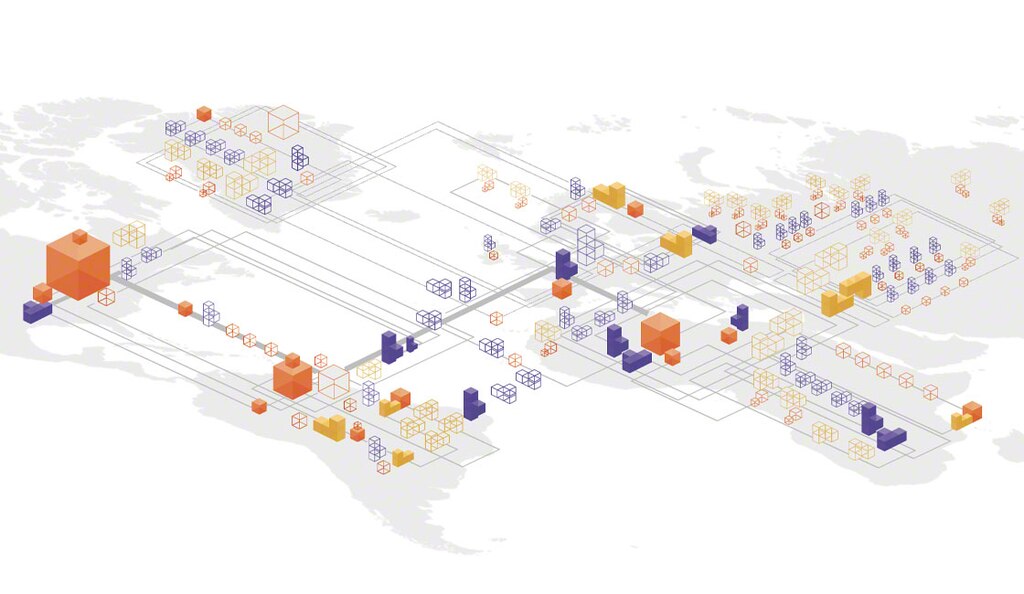
Figure 1 - Schematic illustration of the Physical Internet (Dong and Franklin, 2018)
Standards and connectivity
Standards in global logistics already exist — for containers, pallets and EDI (electronic data interchange) messaging, for instance — but adoption is far from universal. The Physical Internet generalises and significantly extends the notion of standardisation but also, importantly, connectivity.
Universal connectivity is one of the most important features of the Physical Internet and is needed in three ways:
- Physical interconnectivity ensures that shipments can flow seamlessly through the network. This requires standards for containers, transporters and handling systems.
- Digital interconnectivity allows objects and actors to seamlessly exchange meaningful information across the Physical Internet. This aspect of the Internet of Things is already well developed.
- Operational interconnectivity guarantees that in-the-field operational and business processes are seamlessly interconnected so that it is easy and efficient for users to exploit the Physical Internet and for network constituents to collaborate in serving those users. This may prove the hardest to achieve.
Physical interconnection for a seamless flow of goods
Containers
The Physical Internet will not deal with bulk freight, pallets or non-containerised goods. It will only deal with π-container packages of goods. π-containers will come in standard sizes or modules, be environmentally sustainable (built from eco-friendly materials), smart (trackable/routable by RFID and GPS and able to interact with the network), secure, interlocking to create larger units, and, in most cases, capable of being collapsed for more efficient empty storage and return (see Figure 2).
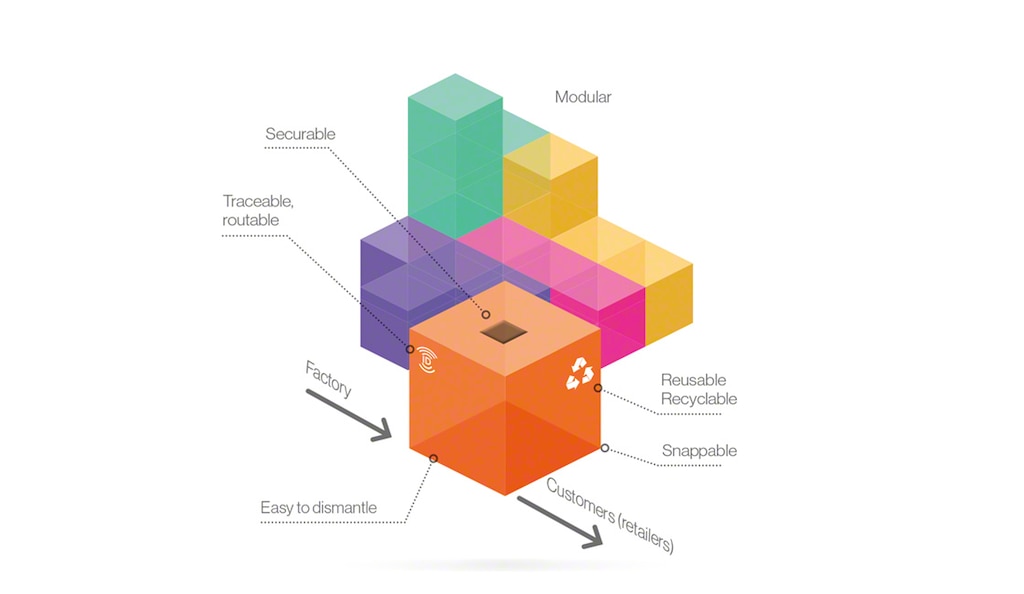
Figure 2 - Characteristics of π-containers
π-containers come in a system of compatible sizes and shapes and can be built up and broken down — much like building blocks in the game of Tetris. Transport containers are equivalent to existing ISO boxes, handling containers are the basic handling units, equivalent to roll cages or pallets, and packaging containers are the basic containers at the item or SKU level.
The Physical Internet will not deal with bulk freight, pallets or non-containerised goods. It will only deal with π-container packages of goods
Movement
In the Physical Internet, π-containers will be moved by π-movers. The main types of π-movers are:
- π-transporters: lorries, trailers and freight cars designed to work with π-conveyors for loading/unloading/transfer.
- π-conveyors, for example, inside transshipment facilities, analogous to current sortation systems. Trials of a number of approaches, not always employing conventional belts or rollers, have been successful (see Figure 3).
- π-handlers: Humans trained to work with π-containers.
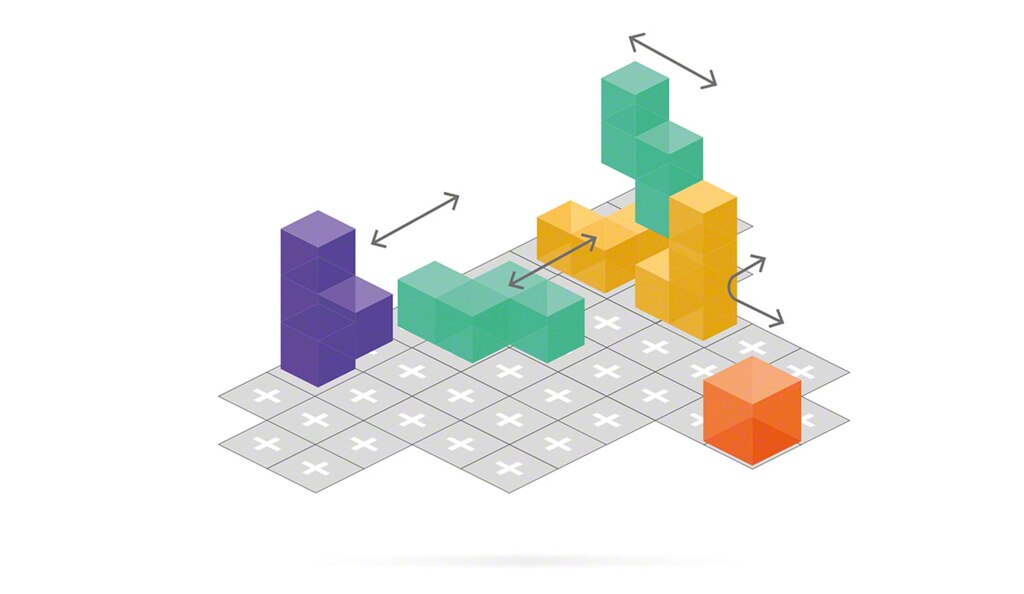
Figure 3 - π-conveyors (Montreuil, 2010)
Nodes
As in a conventional logistics network, there are nodes where consignments can be transferred between transporters or modes. In traditional systems, these nodes often perform other tasks (break-bulk, repackaging, labelling, etc.) to the detriment of transport efficiency. In the Physical Internet, π-nodes will be purely material handling, storage and transfer systems, thus:
- enabling fast and reliable input and output performance;
- providing a seamless interface with vehicles and systems moving products in and out, as well as with client software systems for tracking and interfacing with the π-containers; and
- monitoring, securing and protecting the integrity of π-containers.
π-nodes may have different capabilities, from the simple transfer of π-carriers between π-vehicles (cross-docking) to complex multimodal multiplexing of π-containers. π-nodes would be publicly rated based on key performance indicators such as speed, service, constraints on dimensions of π-containers handled, and capacity. This information will be used by the clients (human or virtual) for routing purposes and other decisions.
Operational connectivity for interconnected transport
Routing optimisation
Currently there are two distinct ways in which freight is transported. Direct or point-to-point service is preferred when volumes justify dispatching a full lorry or train. But if the volumes are too low, shippers attempt to consolidate less than full lorry loads through a series of intermediate nodes (hubs). This is known as hub-and-spoke.
Both systems are inefficient. Direct service can mean that dispatch is delayed until the demand for a full load is present (or that the vehicle runs partially loaded anyway) and often results in empty returns. In hub-and-spoke, it is easier to assemble cargos with a high load factor and secure a backhaul, but a lot of time is then lost and extra costs incurred for intermediate handling and transshipment.
The Physical Internet would significantly shorten average transport times and reduce costs
π holds promise to change this inefficiency. The Physical Internet is a distributed multi-segment intermodal transport network (see Figure 4). Each π-transporter will carry a load up to the next transit hub and then pick up a backhaul and return home within its work shift time. At the π-hub, another transporter (the same or another carrier or mode of transport) would pick up the load within a short time interval and move it on to the next transit hub, determined by what route is best for that container and destination at that moment. This way, the average transport time would be significantly shortened, and costs reduced.
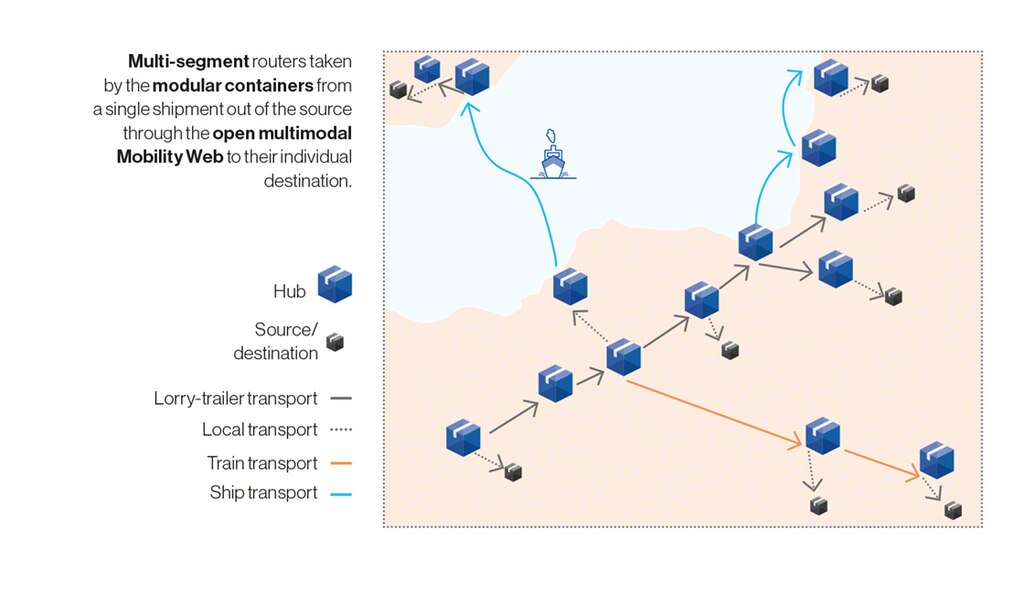
Figure 4 - Enabling an open global mobility web (Montreuil, 2012)
Decision-making autonomy
In the Physical Internet, decisions around routing and other factors can be arrived at in a number of ways. The main aim, however, is to achieve autonomous routing and operation in accordance with agreed procedures and protocols.
- At the lowest level, the π-container does not have any decision-making or smart capability. Shippers or logistics service providers secure complete routes/carriers prior to departure or might specify certain waypoints because, for example, a particular class of freight has to enter a country through a designated border crossing, which would leave the Physical Internet to work out the details autonomously.
- Medium level: the π-container has minimum decision-making autonomy. Human or virtual logistic agents receive information (position, condition) from the π-container (or several containers in a flow), make decisions and relay instructions to the container and the relevant Physical Internet components. These have limited autonomy in cases of an urgent need for decision-making.
- High level: at its most fully developed, the π-container has maximum decision-making autonomy. Shippers specify only the desired dispatch time and location, final destination and optimisation rules (least time, lowest cost, lowest carbon footprint and a weighted score of these). π-containers and other network elements decide on the routing mutually and dynamically, only referring to the human or virtual agent in out-of-bounds situations.
An open Physical Internet
In existing logistics systems, most warehouses and distribution centres are used by just one or a few actors in a private network. The Physical Internet enables a transition from private supply chains to a global, open supply web:
- The nodes would be fully accessible to most actors (manufacturers, distributors, logistics service providers, retailers or other users). Users, thus, have greater freedom over the stocking points of their goods and can make more flexible and responsive replenishment plans.
- Node capacity for processing, storage or movement can also be bought on-demand or on contract, on a usage basis.
It might be expected that warehouse management systems (WMSs) in the Physical Internet would likewise be open and connected. However, for commercial and privacy issues, access to WMS elements may be restricted to one company or a group of related clients. (The digital analogy might be with VPNs, Virtual Private Networks). However, since the Physical Internet is only concerned with containers, not their contents, this is not really an issue.
Figure 5 illustrates the transition from private supply networks to an open, global supply web.
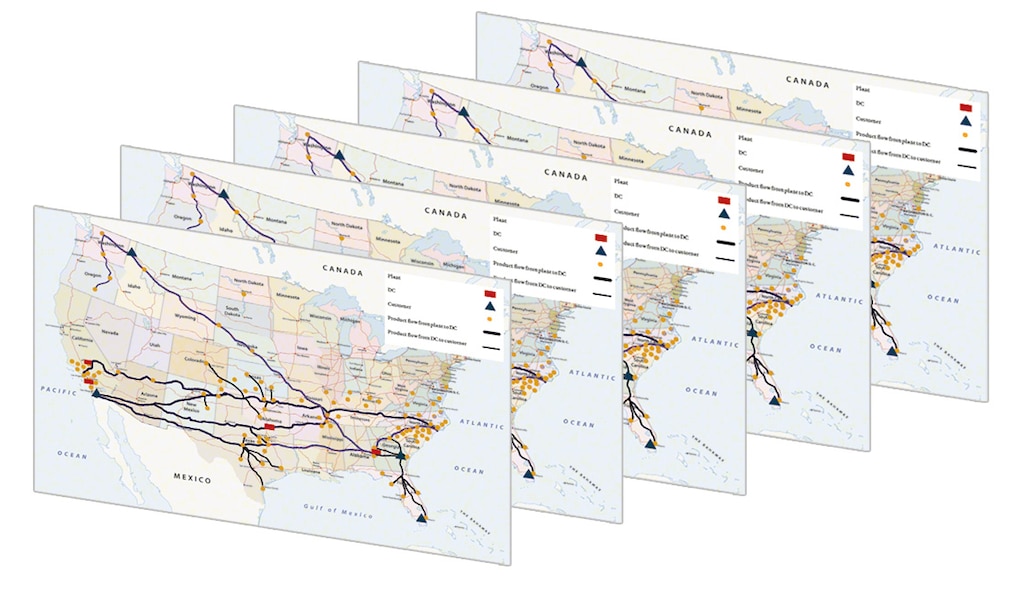
a) Five single-company distribution networks of a closed distribution web
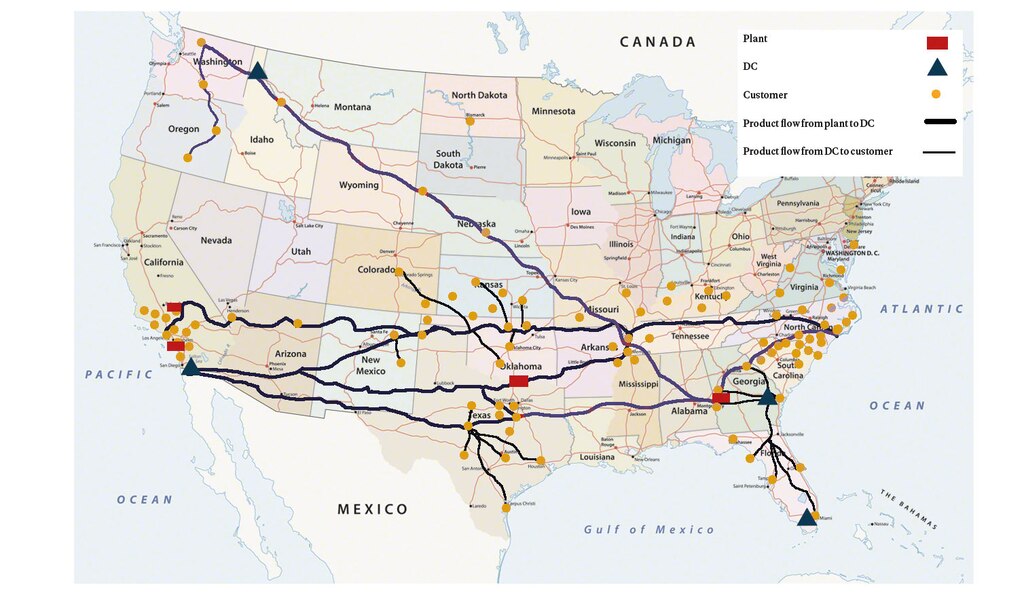
b) Collaborative distribution web dedicated to five partnering companies
Figure 5. Transition from private supply networks to an open, global supply web, with five firms serving the markets in North America (Sohrabi et al., 2012)
An open, global supply web will lead to significant positive effects in terms of reduced lead times, increased utilisation, more efficient use of fixed and mobile assets, and reductions in economic, social and environmental harm.
Summary of the developed Physical Internet proposition
- The Physical Internet is modelled on internet protocols where the movement of packages of information (of data in the Digital Internet and of goods in π) from sender to receiver is automatically organised and performed by the system. This makes for optimal use of the capacity available on the network without any human intervention.
- The organisation is hub-oriented, which means that shipments are brought to the nearest hub and then transported in a global and optimal way to the next hub that can most efficiently serve the destination.
- The physical goods are not themselves handled: the units are exclusively intelligent, green and modular containers.
- Transshipments are done automatically without human intervention. Wait and transshipment times will be short due to the forward-looking, data-driven abilities of the system.
- Inter-hub distances would be chosen by optimising the balance between transshipment costs and vehicle capacity utilisation.
- For long-distance shipments, more than one intermediate hub may be used; however, the loading factor of transport assets will be high, and delays due to congestion will be avoided.
- The shippers and logistics service providers will have real-time information on the shipment’s expected time of arrival.
According to a roadmap proposed by ALICE, full realisation of the Physical Internet is achievable by 2040
What’s not to like?
If the above is a convincing proposition, and the various required technologies are already available, what is impeding implementation of the Physical Internet?
Under the European Green Deal program, the ambition of the European Union is to be the first climate-neutral continent by 2050. The Physical Internet, as probably the most ambitious concept towards efficiency and sustainability in transport, supports the transition towards zero emissions. According to a roadmap proposed by ALICE (Alliance for Logistics Innovation through Collaboration in Europe), full realisation of the Physical Internet is achievable by 2040.
The Physical Internet could mean significant reductions in transport times and costs
However, despite the fact that the Physical Internet offers significant improvements in the agility, robustness, resilience and environmental footprint of supply chains, there is little progress in its implementation. Some of the most important obstacles are:
- The reluctance of businesses to collaborate. Existing collaborative organisations are limited to a few participants and are quite hard to evaluate or generalise so far.
- The lack of universally adopted tools and processes. Existing standards for tools and processes are not well adopted in the logistics sector.
- A universally interconnected network must not only be technically feasible and economically profitable but also acceptable to society and industry. It has to be shown that the Physical Internet can work, first at a limited or pilot level, so as to build trust and consensus about its design and operation. But as with all networks, there is a significant scale effect, and small-scale demonstrations may not reveal the larger benefits convincingly.
One way to promote the development and adoption of the Physical Internet would be a phased approach with incremental growth in terms of complexity and coverage. This could be achieved though planned, targeted and continuous research and innovation action based on intensive collaboration between industry and academia.
Dr Milos Milenkovic worked as a Research Fellow at ZLC. Currently, he is an Assistant Professor in the Faculty of Transport and Traffic Engineering at the University of Belgrade, Serbia. Dr. Milenkovic holds a PhD degree in Technical Sciences in the field of Traffic and Transport with a focus on rail freight car scheduling and fleet sizing problems, a Magisterial degree of Technical Sciences with a focus on train dispatching problems and an MSc degree based on railway related intelligent transport systems from the Faculty of Transport and Traffic Engineering (University of Belgrade).
